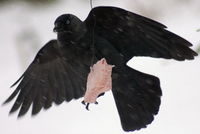Jackdaw
2007 Schools Wikipedia Selection. Related subjects: Birds
| iJackdaw | ||||||||||||||
|---|---|---|---|---|---|---|---|---|---|---|---|---|---|---|
 |
||||||||||||||
|
|
||||||||||||||
 Least Concern (LC) |
||||||||||||||
| Scientific classification | ||||||||||||||
|
||||||||||||||
|
|
||||||||||||||
| Corvus monedula (Linnaeus, 1758) |
||||||||||||||
 Jackdaw range
|
The Jackdaw (Corvus monedula) is one of the smallest species (34–39 cm in length) in the genus of crows and ravens.
Description
Most of the plumage is black or greyish black except for the cheeks, nape and neck, which are light grey to greyish silver. The iris of adults is greyish white or silvery white, the only member of the genus outside of the Australasian region to have this feature. The iris of juvenile jackdaws is light blue. The bird is sociable, moving around in pairs (male and female) or in larger groups, though the pairs of birds stay together within the flocks.
Distribution and habitat
Jackdaws are found over a large area stretching from North West Africa through virtually all of Europe, Iran, north-west India and Siberia, where they inhabit wooded steppes, woodland, cultivated land, pasture, coastal cliffs and villages and towns.
Behaviour
Diet
The Jackdaw mostly takes food from the ground but does take some food in trees. It eats insects and other invertebrates, weed seeds and grain, scraps of human food in towns, stranded fish on the shore, and will more readily take food from bird tables than other Corvus species.

Nesting
Jackdaws usually nest in colonies in cavities of trees, cliffs or ruined buildings and sometimes even in dense conifers. Eggs, normally 4-5, are incubated for 17-18 days and fledge after 30-35 days.
Voice
The voice is a "tchak-tchak" or "kak-kak" call.
Social behaviour
The complex social interactions that occur in groups of Jackdaws was studied by Konrad Lorenz and he published detailed descriptions of the Jackdaw's social behaviours in his book " King Solomon's Ring". Lorenz put coloured rings on Jackdaws' legs so that individual birds could be easily identified and he caged them in the winter because of their annual migration from Austria. Lorenz observed Jackdaws' hierarchical group structure with dominance of the higher-ranking birds over others. He noticed Jackdaws' strong male–female bonding and that each bird of a pair occupy about the same position in the hierarchy. He reported that a low-ranked female Jackdaw rocketed up the Jackdaw social ladder when she became the mate of a high-ranking male. He also described some Jackdaw calls.
Jackdaws have been observed sharing food and objects. The active giving of food is rare in primates, and in birds is found mainly in the context of parental care and courtship. Jackdaws show much higher levels of active giving than documented for chimpanzees. The function of this behaviour is not fully understood, although it has been found to be compatible with hypotheses of mutualism, reciprocity and harassment avoidance.
Other jackdaws
Another species closely related to European Jackdaw is the Daurian Jackdaw (Corvus dauricus) of eastern Asia. The European and Daurian Jackdaw together form the subgenus Coloeus.
Trivia
- "Kavka", the Czech word for jackdaw, is the origin of Franz Kafka's surname
- In some cultures, a Jackdaw on the roof is said to predict a new arrival; Alternatly, Jackdaw settling on the house is an omen of death and coming across one is considered a bad omen
( http://www.oldsuperstitions.com/animal.html)
- A popular pangram (and one used by the Windows XP operating system when previewing some fonts) is "Jackdaws love my big sphinx of quartz."
Image links
- Urban bird
- Jackdaw on coastal cliffside
- Skull of Jackdaw
Video links
- Jackdaw videos on the Internet Bird Collection